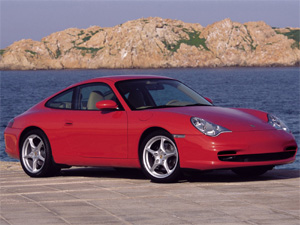


This edition of the Aston-Martin DB7 3.2 V6 is the 6 speed / Manual version and was first brought out in 1993. This was at around the same time as the introduction of the 1994 McLaren F1 6.1 V12 and the 1993 Jaguar XJ 220 S 3.5 V6 Turbo.This particular Aston-Martin DB7 has a 3239cc Naturally Aspirated Petrol powerplant with 6 cylinders in a V formation.
The DB7 shares its Petrol V6 engine configuration with the likes of the 2014 Radical RXC 3.5 V6 Twin Turbo and the 2015 Radical RXC Turbo 500 3.5 V6. If you're looking for other fast cars which share the DB7's Rear Wheel Drive, Coupe combination then how about the 1982 Fiat X1/9 1.5 8V or the 1965 Aston-Martin DB6 1965.
Weighing in at 1750 kgs (3858 lbs) this makes the Aston-Martin DB7 3.2 V6 in the same weight category as the 2022 BMW 2 Series M2 3.0 Twin Turbo G87 or the give or take 50kg.
In terms of power the 3239cc 24V V6 engine produces 335 bhp (249 kW) @ 5500 rpm similar to the 2024 Mazda CX-90 S 3.3 Turbo (340 bhp) or the 2023 Porsche Cayenne Coupe 3.0 V6 Turbo (348 bhp).
The Naturally Aspirated V6 throws out 360 lb-ft (488.0 Nm) @ 3000 rpm placing it with cars of similar torque performance figures such as the 2024 Mazda CX-90 S 3.3 Turbo (369 lb-ft) or the 2023 Porsche Cayenne Coupe 3.0 V6 Turbo (369 lb-ft).
If one combines the weight with power or torque performance for the Aston-Martin DB7 you can get a better idea of it's real world performance.
The 1968 Ford Mustang GT 6.4 V8 2+2 Fastback (216.2 bhp per ton) has similar Bhp Per Ton stats as the Aston-Martin DB7.
The Aston-Martin DB7 has a Power to weight ratio of 191.4 bhp per ton and 205.7 lb-ft per ton. Bhp Per Ton figures of the 1993 DB7 competing with the 1968 Ford Mustang GT 6.4 V8 2+2 Fastback (216.2 bhp per ton) or the 2004 Chrysler 300 6.1 SRT-8 (216.2 bhp per ton).
If you agree with the late great Carroll Shelby then arguably an even better indicator of potential performance, Torque. Use weight as well and you end up with - Torque per ton, with the Aston-Martin DB7 generating around 205.7 lb-ft per ton. If you're curious as to what other cars have as much torque to weight then look no further than the 2010 Ford Mustang Boss 302 (230.7 lb-ft per ton) or the 1991 Porsche 928 GTS 5.4L V8 (230.6 lb-ft per ton).
With a 0-60mph time of 5.20 secs or a 0-100km/h (0-62mph) of 5.4 secs, this made the Aston-Martin DB7 3.2 V6 as fast as the 2021 Honda Civic Type R 2.0 16V Limited Edition (5.20 secs) the 2021 Ford Mustang Mach-E AWD (5.20 secs) the 2018 BMW X7 xDrive 50i 4.4 V8 Turbo (5.20 secs) the or the 2018 Tesla Model 3 Mid Range (5.20 secs). This Aston-Martin DB7 3.2 V6 is also faster than the 2019 Renault Megane RS 1.8 Turbo 300 Trophy-R (5.30 secs) the 2019 Tesla Model 3 Standard Range Plus (5.30 secs) the 2017 Mercedes G Class 63 AMG (5.30 secs) the and the 2017 Land-Rover Velar 3.0 V6 Supercharged 360 (5.30 secs).
When talking about the performance of the Aston-Martin DB7 on the drag strip it can reach a quarter mile in an estimated 14.15 secs @ 96.7 mph. Similar performance down the quarter mile can be found with the the 2003 Nissan 350Z 300 GT Coupe (14.08 secs), the 2003 Mercedes CLK 55 AMG Cabriolet (14.08 secs), and the 2011 Ford Focus 2.0 ST-3 (14.09 secs).
Modern performance cars are often artificially restricted to 155mph. The 1993 version of the Aston-Martin DB7 3.2 V6 has a maximum speed of 157mph.
If maxing out your car on the AutoBahn is your thing and you're wondering what's faster than the 1993 Aston-Martin DB7 3.2 V6 then how about the 2022 Volkswagen-VW Golf R Performance 2.0 Turbo (168 mph), the 2020 KIA Stinger GT 3.3 V6 Turbo AWD (168 mph), or the 2020 KIA Stinger GT2 3.3 V6 Turbo (168 mph).









Porsche Cayenne 4.8 V8 Turbo S
Engine: Turbo Petrol | 4806cc 32v V8
Top Speed: 176 mph
0-60mph: 4.30 seconds

Caterham Super 7 1.4 Supersport
Engine: Naturally Aspirated Petrol | 1396cc 16v St4
Top Speed: 183.4 kph
0-100kph: 6.2 seconds



















